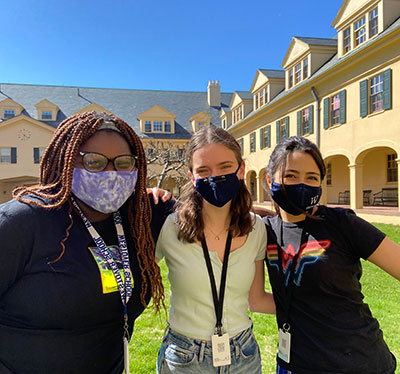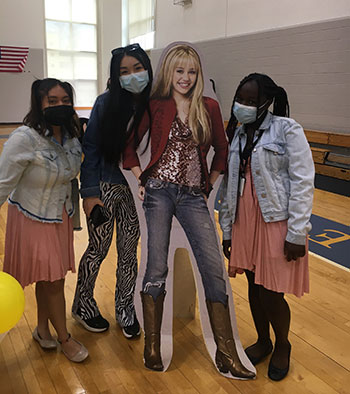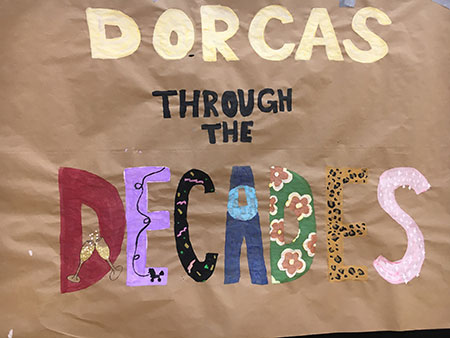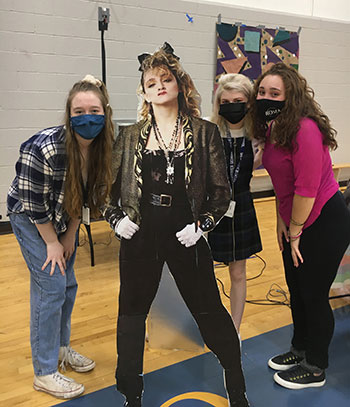
The Class of 2022 — under the leadership of this year’s Dorcas Heads Sarah Adams, Tate Dunbar, and Morry Ajao — did not let the challenges of the COVID-19 pandemic undermine the success of this year’s Dorcas Fair, both as a fundraising for charity and as an opportunity for Westover to celebrate as a community.
A total of $4,500 was raised from the April hybrid event, which combined both the traditional Dorcas Fair held in the School’s Fuller Athletic Center, which was open to boarders, day students, faculty, and staff and — for the first time in the history of the fair — a virtual silent auction. That event was open to students, as well as their families, faculty and staff, alumnae, and other members of the Westover community from around the world.
event was open to students, as well as their families, faculty and staff, alumnae, and other members of the Westover community from around the world.
The fair’s proceeds — combined with $16,200 in allocations made in December from the Dorcas Fund set up through the Connecticut Community Foundation, for a grand total of $20,700 distributed during the 2020-2021 academic year — were given to four non-profit organizations selected by the Class of 2022:
• The Boys & Girls Club of Greater Waterbury, which provides a range of enrichment programs for area children;
• Habitat for Humanity of Greater Waterbury, which builds and renovates homes for people in need of adequate housing;
• St. Jude’s Children’s Research Hospital, based in Memphis, Tennessee, which conducts research and provides treatment for children with cancer and other life-threatening diseases;
• UNICEF, the United Nations International Children’s Emergency Fund, a UN agency responsible for providing humanitarian and developmental aid to children worldwide.
Each of the organizations received a total of $5,175 from this year’s Dorcas program.
 Robyn Ames, Westover’s Community Service Director who also serves as the Dorcas Advisor, credits the leadership of this year’s three Dorcas Heads for finding ways to plan and run a successful Dorcas Fair despite the complications of doing so under pandemic conditions — including making sure that their classmates were engaged in preparations for the fair every step of the way, even though some were attending Westover for either part or all of the year while in homes ranging from a few miles from the School to the other side of the world.
Robyn Ames, Westover’s Community Service Director who also serves as the Dorcas Advisor, credits the leadership of this year’s three Dorcas Heads for finding ways to plan and run a successful Dorcas Fair despite the complications of doing so under pandemic conditions — including making sure that their classmates were engaged in preparations for the fair every step of the way, even though some were attending Westover for either part or all of the year while in homes ranging from a few miles from the School to the other side of the world.
A Westover tradition dating back to the founding of the School, the Dorcas Fair is planned and run each year by the junior class to raise funds for non-profit organizations.
Robyn said that Sarah, Tate, and Morry led the discussions with their classmates on the selection of the four organizations for this year’s fundraising efforts. In their research, they drew on the UN’s Sustainable Development Goals, which identified “17 global goals designed to be a ‘blueprint to achieve a better and more sustainable future for all.”’ These included such long-range goals as the elimination of poverty and hunger as well as provisions for supporting education, good health and well-being, and sustainable communities.
Using these guidelines, the class identified a range of organizations based in the United States that address these humanitarian goals on the local, national, and international level.
“We believe that all four of these organizations align with our goals,” Tate said, “and we aimed to spread our donations out across both local and global organizations.”
“We decided early on that the charities that we would donate to would be ones focused on alleviating poverty,” Morry added. “When it came time to decide on the actual charities, we wanted to donate to both bigger and smaller charities, so we did a mix of both. Personally, the pandemic made me more aware of financial inequality and the prevalence of poverty worldwide, so when discussing a focus for Dorcas with my fellow heads, the idea was at the forefront of my mind.”
In planning for this year’s Dorcas Fair, Robyn and the three heads agreed that the impact of the pandemic on the School’s on-campus routine was a source of concern — first determining whether they would even be able to hold the fair on campus, figuring out how the class would be able to prepare for the event, and also how to successfully engage those parts of the School community who would remain “virtual.”
“I think the biggest challenge and source of frustration this year was the uncertainty of the situation” Tate acknowledged. “Not knowing for sure until winter whether we would be able to have the fair in person was quite stressful. Then having to create a fair both in person and virtually was a challenge, especially with limited in-person work-time.”
until winter whether we would be able to have the fair in person was quite stressful. Then having to create a fair both in person and virtually was a challenge, especially with limited in-person work-time.”
Early in the school year, Robyn recalled, “when the heads talked about possibly having part or all of the event as a ‘virtual’ fair, I couldn’t even fathom how we would do it.” But, she said, the three members of the class did research and found a way of using Patchwork — a free, web-based patch-tracking system — that would enable the class to set up the virtual fair, as well as another platform, 32 Auctions, to run the virtual silent auction.
“That was something totally out of the box,” Robyn said, “to come up with something new for the fair. In the end, it went over so well. And, for the first time, we were able to offer to parents and others who can’t come to the fair on campus a way of supporting our fundraising efforts.” As a result, she added, the online silent auction will become a part of future Dorcas fairs.
Another challenge in pulling off this year’s Dorcas Fair, Morry said, “was trying to organize with our classmates all over the world. Dorcas is a community event, and we wanted our international students and boarders to feel as if they played a part in the planning process, but that proved to be challenging at times.”
As Sarah noted, communicating directly with classmates was an additional complication. “Having to communicate through email would add an extra step,” she admitted, “but we were able to work through that.” Later in the school year, boarders returning to campus also meant most of the junior class was able to meet — at a safe social distance — to work on preparations for the fair.
This year’s theme – Dorcas Through the Decades —also meant the juniors could design a fair that consisted a series of tables and booths, complete with period costumes, foods, and cultural artifacts, that gave fairgoers not only a journey through time, but also a safe, one-way path through the activities.
Robyn praised Sarah for designing and creating the 10 life-sized photographic cutouts of celebrities from different eras — ranging from Elvis to Harry Styles — that greeted attendees as they moved through the fair.
As this year’s juniors gathered together to work on Dorcas preparations, Robyn said she noticed that they seemed to really be enjoying one another’s company — perhaps because social distancing had cut down on opportunities to do so during the adjusted school day.
Robyn also praised the work of international juniors and their families who contributed many of the donated items for the silent auction, assisted with the designs for Dorcas apparel offered for sale, and gave helpful suggestions for food items to sell at the fair’s booths.
 To help spark excitement in this year’s Dorcas, Robyn noted, the three heads came up with Dorcas Care Packages at the beginning of the school year that were sold to the extended Westover community. The packages not only raised additional funds, but also helped generate early interest in the fair. Each care package included a Dorcas pencil case, stickers, erasers, and notecards.
To help spark excitement in this year’s Dorcas, Robyn noted, the three heads came up with Dorcas Care Packages at the beginning of the school year that were sold to the extended Westover community. The packages not only raised additional funds, but also helped generate early interest in the fair. Each care package included a Dorcas pencil case, stickers, erasers, and notecards.
Robyn was impressed by the team work of this year’s three heads. “They really were a pleasure to work with,’ she said, and showed unflagging imagination, energy, and a positive attitude.
“They worked together so well,” Robyn recalled. “They were just chill.” They each took on different roles in the process, she added. “Sarah was creative, offering ideas like the cutouts of celebrities. Tate was the organized taskmaster — she would say, ‘This is the day we have to do this and we are going to have to get it done now.’ Morry was the one who got everyone fired up about various aspects of the fair, but she also was the calming influence.”
“We were all very good about getting stuff done,” Sarah agreed. “We all knew what was going on at all times, but we were able to divide up our duties. We just knew we could get it all done. And we were ready to pick up each other’s slack if someone needed help.”
“I think we worked incredibly well as a team,” Morry noted, “because we each brought something completely different to the table, and it was clear we were all passionate about being able to pull Dorcas off. I value their attentiveness and preparedness; they helped keep me on track and had a solution to every bump in the road.”
Before she took on her Dorcas Head responsibilities, Sarah added, “I didn’t think I was a decision-maker. In the past, I was hesitant to make big decisions because I was afraid I would hurt someone’s feelings.” As the year progressed, however, she became more confident in her decision-making abilities.
Tate was proud of the heads’ efforts to create the virtual silent auction. “While it was a lot of work to find a website to use, take pictures, and coordinate the experience,” she recalled, “it was really wonderful to be able to bring the silent auction to a wider community than would generally be possible.”
For Morry, “Dorcas helped me define my personal leadership style — more authoritative and primarily driven by communication. Being a Dorcas head confirmed my ability to take more creative approaches to problem-solving, as this was a very unconventional year. Working with my other heads and my class as a whole, I learned the importance of open communication. It establishes a healthy relationship and ensures that the entire operation runs smoothly, as people work better when they understand precisely what needs to be done.”
“The fact that we even had a fair was satisfying enough,” Morry added, “but I am so proud of my classmates’ dedication. I was in awe of their hard work throughout the entire process, and there were many moments where their effort helped keep me going.”
Echoing Morry, Sarah said, “I am grateful for everyone in our class. Even though we weren’t sure what was going to happen at the beginning of the year, we made it happen. I am also grateful to the entire School community. Dorcas is a great tradition, and when we were able to make it happen it reminded me of how valuable it is to the School as a whole.”
Robyn also expressed her thanks to Susan Loyd-Turner, one of Westover’s Spanish teachers who served as an assistant Dorcas advisor this year, working alongside Robyn, the heads, and the junior class. Robyn also thanked Jen Hill, the Director of the Health Center, and Lauren Castagnola, the School’s Chief of Staff, who coordinated the School’s COVID response efforts this year, along with Dean of Students Tasheana Dukuly.
Thanks to their efforts, and the support of other faculty and staff, Robyn said that this year’s Dorcas Fair was a success — not just in terms of fundraising but in being an event the entire school community could celebrate together.





.jpg&command_2=resize&height_2=85)




%20(1)%20(1).jpg&command_2=resize&height_2=85)


.jpg&command_2=resize&height_2=85)
.JPG&command_2=resize&height_2=85)

%20w%20Raleway.jpg&command_2=resize&height_2=85)



